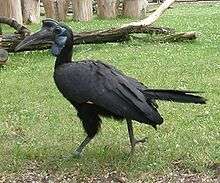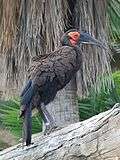Ground hornbill
| Ground hornbill Temporal range: Middle Miocene to present | |
|---|---|
| Southern ground hornbill (Bucorvus leadbeateri) | |
| Scientific classification | |
| Kingdom: | Animalia |
| Phylum: | Chordata |
| Class: | Aves |
| Order: | Bucerotiformes |
| Family: | Bucorvidae Bonaparte, 1854 |
| Genus: | Bucorvus Lesson, 1830 |
| Species | |
|
Bucorvus leadbeateri | |
The ground hornbills (Bucorvidae) are a family of the order Bucerotiformes, with a single genus Bucorvus and two extant species (though possibly including another genus with six extant species). The family is endemic to Sub-Saharan Africa: the Abyssinian ground hornbill occurs in a belt from Senegal east to Ethiopia, and the southern ground hornbill occurs in Southern and East Africa.
Ground hornbills are large, with adults around a metre tall. Both species are ground-dwelling, unlike other hornbills, and feed on insects, snakes, other birds, amphibians and even tortoises.[1] They are among the longest-lived of all birds,[2] and the larger southern species is possibly the slowest-breeding (triennially) and longest-lived of all birds.[3]
Taxonomy
Ornithologists consider the hornbills a distinct order Bucerotiformes and usually raise the ground hornbills to family level (Bucorvidae) on account of their distinctness. The genus Bucorvus contains two extant species:
| Image | Scientific name | Common Name | Distribution |
|---|---|---|---|
 | Bucorvus abyssinicus | Abyssinian ground hornbill(also known as northern ground hornbill) | southern Mauritania, Senegal and Guinea east to Eritrea, Ethiopia, north western Somalia, north western Kenya and Uganda |
 | Bucorvus leadbeateri | Southern ground hornbill | northern Namibia and Angola to northern South Africa and southern Zimbabwe to Burundi and Kenya |
A prehistoric ground hornbill, Bucorvus brailloni, has been described from fossil bones in Morocco, suggesting that prior to Quaternary glaciations the genus was either much more widespread or differently distributed.[4]
It is currently thought that the ground hornbills, along with Tockus and Tropicranus, are almost exclusively carnivorous[1] and lack the gular pouch that allows other, less closely related hornbill genera to store fruit.
Recent genetic data shows that ground hornbills form a clade with Bycanistes, this clade being a sister taxon to the rest of the hornbill lineage.[5] Bucorvidae are thought to represent an early African lineage, while the rest of Bucerotiformes evolved in Asia.
References
- 1 2 Kinnaird Margaret F. and O‘Brien< Timothy G.; The Ecology and Conservation of Asian Hornbills: Farmers of the Forest; pp. 20-23. ISBN 0226437124
- ↑ Wasser, D. E. and Sherman, P.W.; “Avian longevities and their interpretation under evolutionary theories of senescence” in Journal of Zoology 2 November 2009
- ↑ Skutch; Alexander Frank (author) and Gardner, Dana (illustrator) Helpers at birds' nests : a worldwide survey of cooperative breeding and related behavior pp. 69-71. Published 1987 by University of Iowa Press. ISBN 0877451508
- ↑ Kemp, A. C. 1995 The Hornbills. Oxford University Press, Oxford.
- ↑ Woodruff, D. S. & Srikwan, S. 2011. Molecular genetics and the conservation of hornbills in fragmented landscapes. In Poonswad, P. (ed) The Asian Hornbills: Ecology and Conservation. National Center for Genetic Engineering and Biotechnology, Bangkok, pp. 257-264.
External links
| Wikimedia Commons has media related to Bucorvus abyssinicus. |